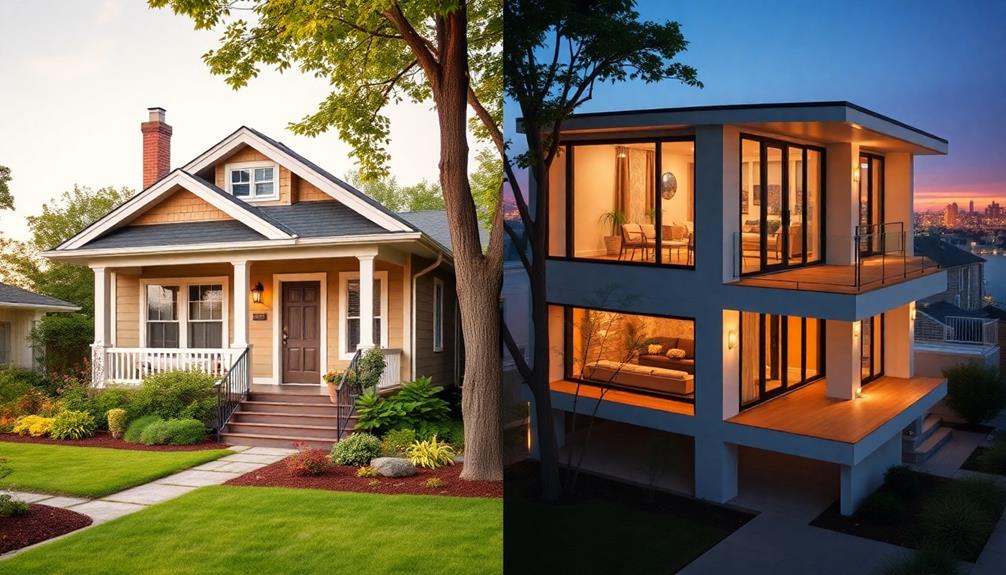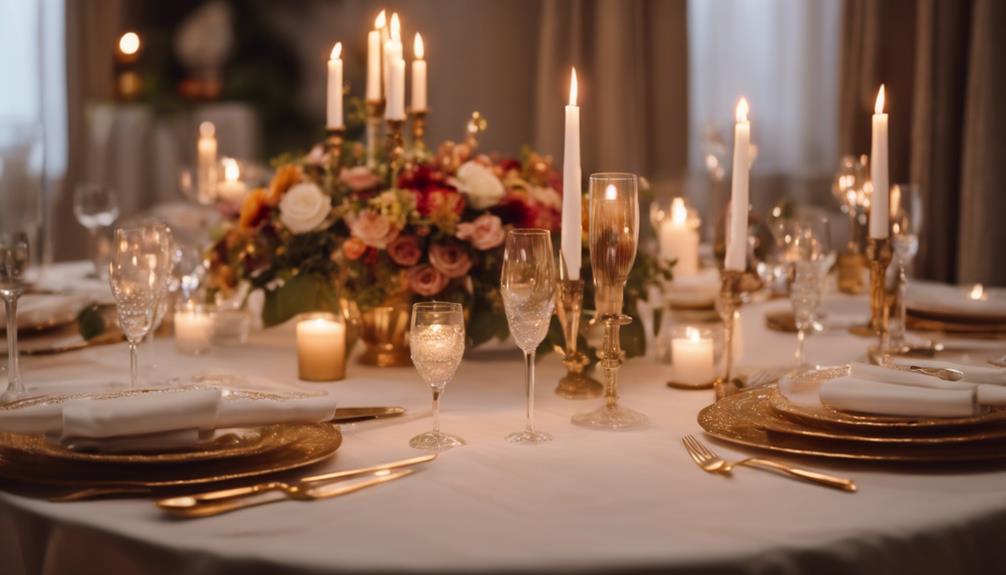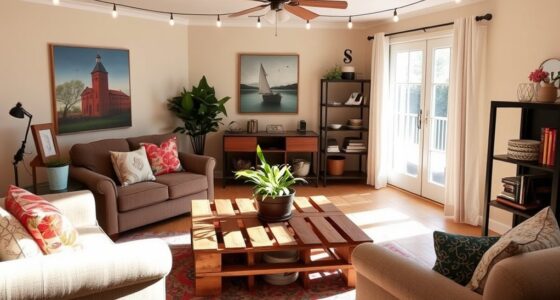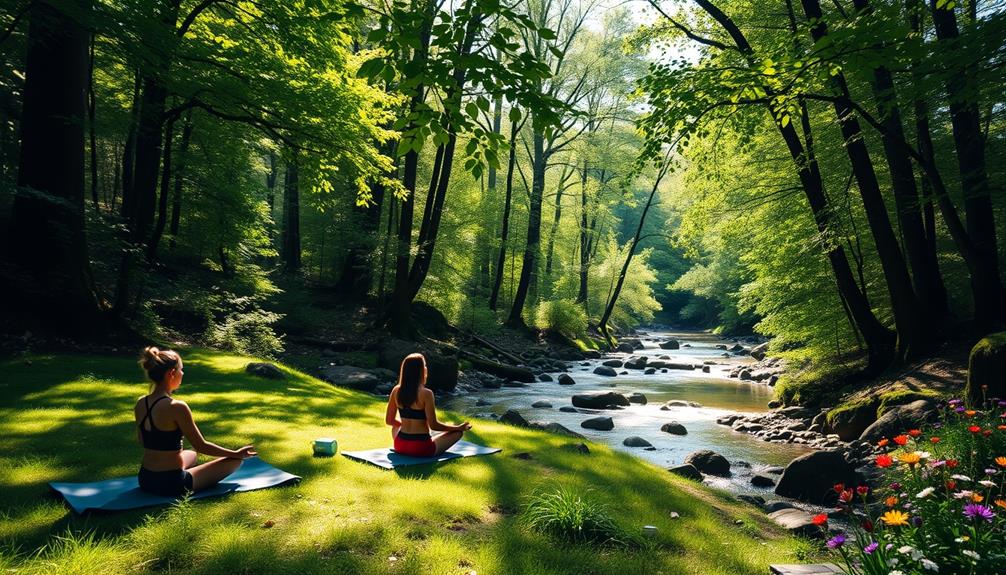When you compare bungalows and two-storey homes, you'll find each offers unique advantages. Bungalows provide single-level living, making them perfect for easy access and maintenance. They're great for individuals with mobility concerns and require less upkeep overall. On the other hand, two-storey homes maximize space by building upwards, appealing to families seeking privacy and room. They do entail more complex maintenance, especially with HVAC systems. Ultimately, your choice should align with your lifestyle and future needs. Stick around to discover more about what suits you best and how each type can meet your specific requirements.
Key Takeaways
- Bungalows provide easier accessibility, making them ideal for individuals with mobility issues and reducing fall risks associated with stairs.
- Two-storey homes maximize land usage, offering more living space and privacy, appealing especially to families.
- Maintenance is simpler in bungalows due to their single-level design, while two-storey homes may require more complex systems and professional help.
- Bungalows generally attract a wider audience for resale, while two-storey homes can retain higher value with the right renovations and market appeal.
- Customization options are available for both home types, allowing homeowners to adapt layouts and designs to fit their lifestyles and future needs.
Space Considerations
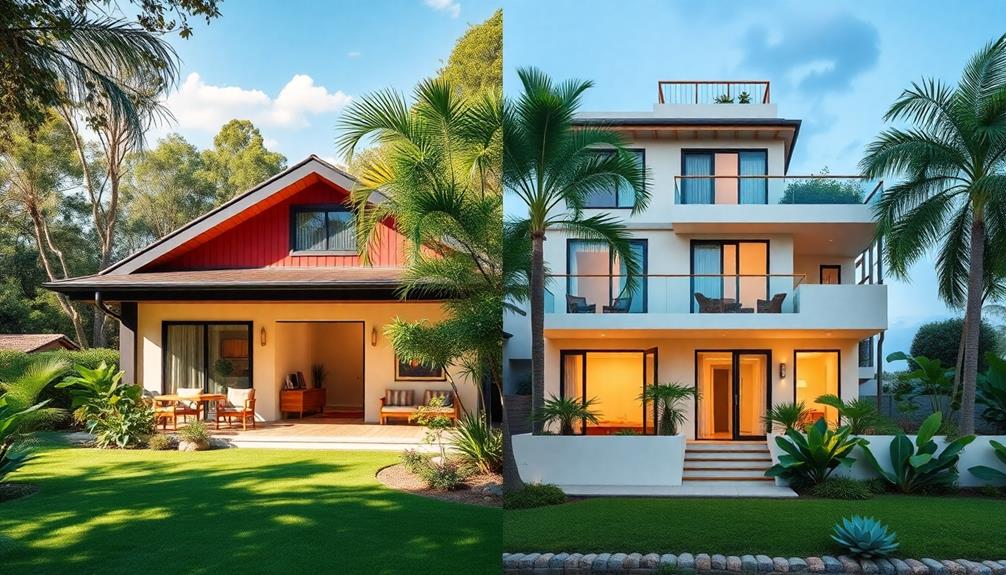
When it comes to space considerations, bungalows and two-storey homes offer distinct advantages.
If you prioritize convenience, bungalows provide single-level living, making it easy for everyone in the family to access all areas without climbing stairs. Their smaller footprint allows for simple expansions, letting you increase your living space as your needs change.
On the other hand, two-storey homes maximize your land usage by building upwards. This vertical layout not only creates more room but also separates living areas, enhancing both privacy and organization. You can enjoy distinct spaces for different activities, making your home feel more spacious overall.
Ultimately, your choice hinges on whether you prefer horizontal or vertical living.
Maintenance Requirements
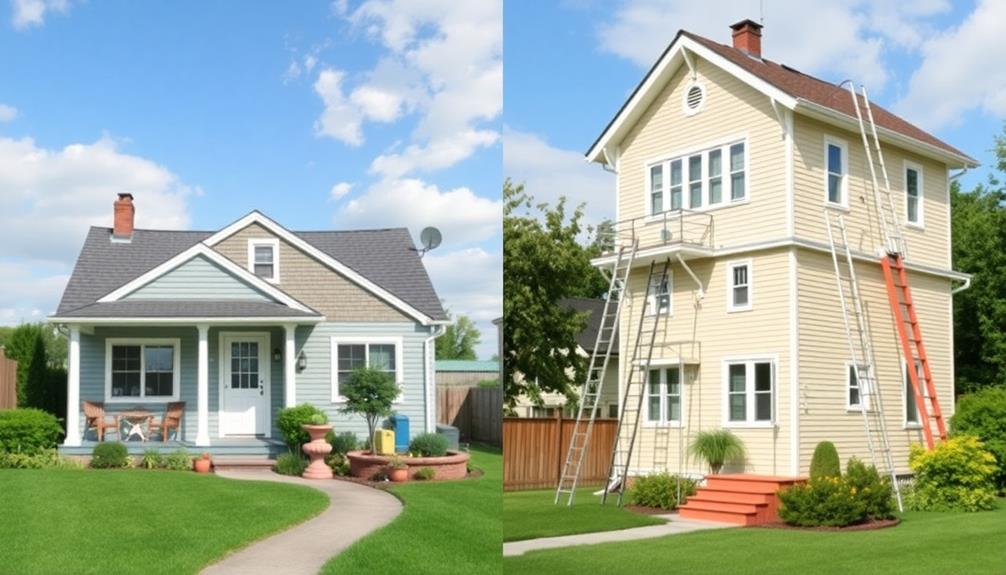
Considering maintenance requirements, bungalows generally have the upper hand due to their simpler structure and single-level accessibility.
With everything on one floor, you'll find tasks like cleaning gutters and performing roof repairs much easier. You won't need to deal with complicated systems that two-storey homes often require, such as dual HVAC setups.
In a two-storey house, maintaining the roof can be more challenging and may need specialized equipment, which can escalate costs.
Additionally, gutter cleaning in these homes usually requires professional help due to the height.
Resale Value
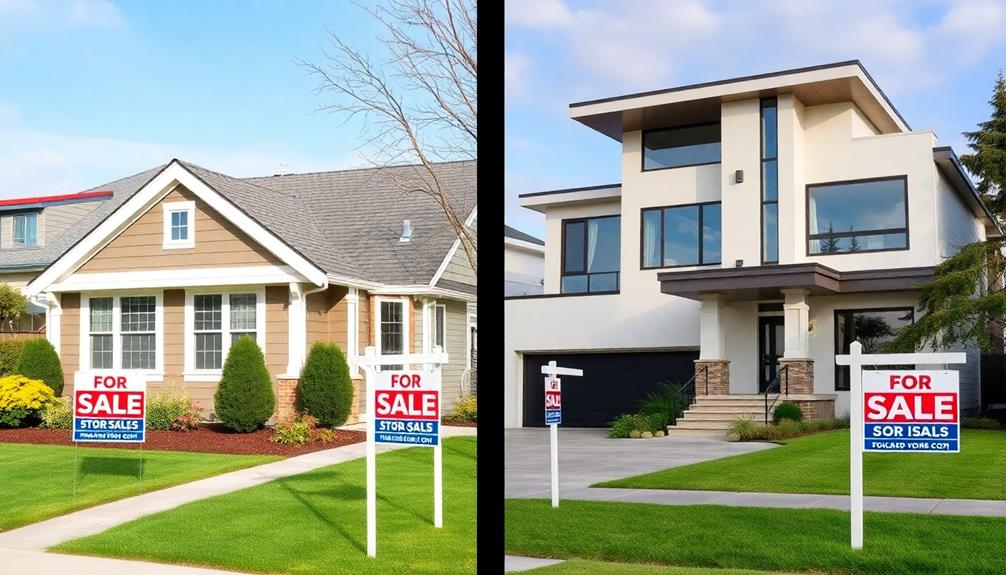
Many homeowners find that resale value is a crucial factor in their decision-making process. When considering bungalows versus two-storey homes, it's important to weigh their market appeal. Bungalows often attract a wider audience thanks to their accessibility, while two-storey homes usually appeal to families looking for more space.
Here's a quick comparison:
| Home Type | Resale Value Appeal |
|---|---|
| Bungalow | Broad audience, easy accessibility |
| Two-Storey | Families seeking space and privacy |
| Market Trends | Well-maintained homes retain value |
Ultimately, both types can enhance their resale value through renovations. Your choice should align with your lifestyle needs and future market trends.
Customization Options
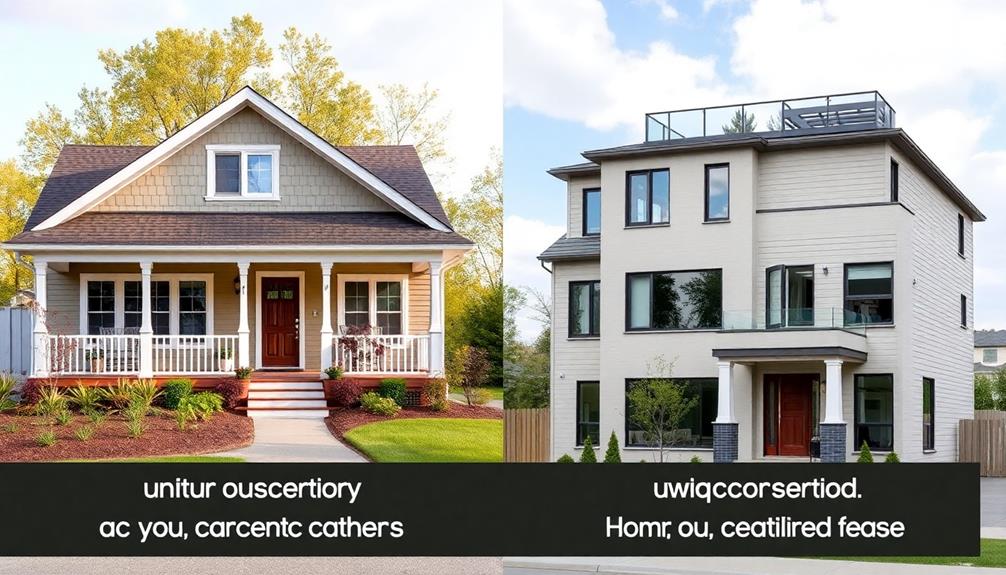
Customization options play an essential role in making a house truly feel like home.
Whether you choose a bungalow or a two-storey, personal touches can enhance your living experience.
Here are some key customization aspects to reflect upon:
- Interior Layout: Tailor spaces to fit your lifestyle, like open-concept designs or cozy nooks.
- Exterior Design: Choose colors, materials, and landscaping that reflect your personality and style.
- Energy-Efficient Upgrades: Incorporate modern technology to reduce costs and increase comfort, like smart thermostats or solar panels.
- Room Functionality: Adapt rooms for specific uses, such as a home office, gym, or guest suite, maximizing your home's potential.
With thoughtful customization, both bungalows and two-storey homes can evolve into your unique sanctuary.
Accessibility and Future Needs
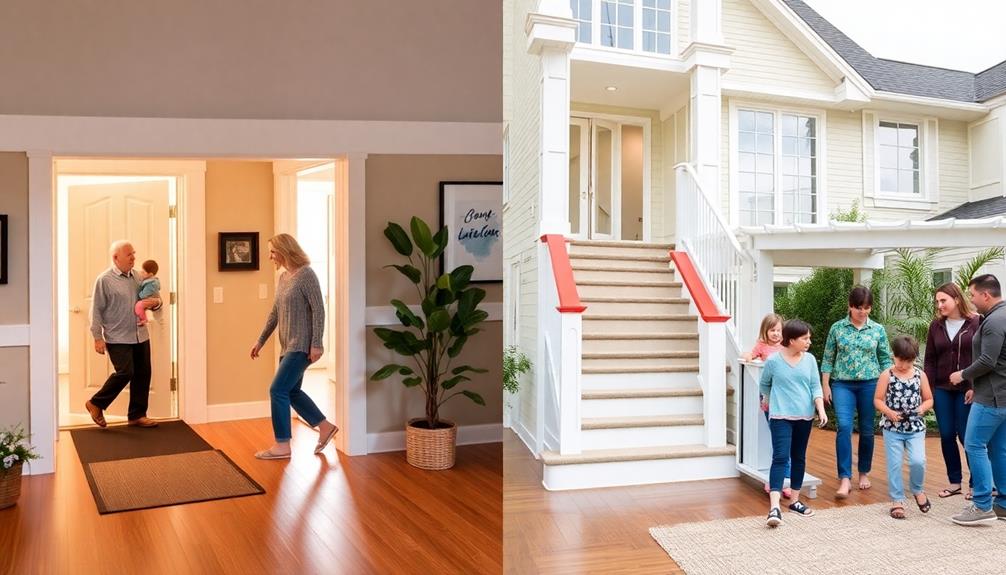
Accessibility plays an essential role in choosing the right home for your future needs.
If you or your family members have mobility issues, a bungalow might be the better option. Its single-level layout eliminates stairs, reducing the risk of falls and making daily activities easier.
On the other hand, two-storey homes can pose challenges as you age, often requiring renovations like stairlifts or additional bedrooms on the main floor. While you can integrate accessibility features into a two-storey home, it's usually more straightforward in a bungalow.
Consider how long you plan to live in your home and whether it can adapt to your future needs. Making the right choice now can save you stress and expense later on.
Frequently Asked Questions
What Are the Typical Costs Associated With Building a Bungalow Versus a Two-Storey Home?
When considering costs, bungalows usually require less due to simpler structures and fewer materials. Two-storey homes often have higher costs from complex systems, additional materials, and potential maintenance expenses, so plan your budget accordingly.
How Do Energy Efficiency Ratings Compare Between Bungalows and Two-Storey Homes?
When comparing energy efficiency, you'll find bungalows often have lower utility costs due to their compact design. Two-storey homes can be efficient too, but they may require more energy for heating and cooling across multiple levels.
What Are the Insurance Implications for Bungalows Versus Two-Storey Homes?
Imagine two ships in a harbor. Insuring a bungalow's often simpler, with lower premiums due to reduced risks. In contrast, two-storey homes might face higher rates from added complexities like multiple levels and potential hazards.
How Do Neighborhood Aesthetics Differ Between Bungalows and Two-Storey Homes?
When considering neighborhood aesthetics, you'll notice bungalows often blend with natural surroundings, creating a cozy feel. In contrast, two-storey homes can stand out, showcasing architectural variety and offering a more pronounced presence within the community.
Are There Specific Zoning Regulations Impacting Bungalows Compared to Two-Storey Houses?
Yes, specific zoning regulations can impact bungalows and two-storey houses differently. You'll need to check local guidelines, as they may dictate height restrictions, lot coverage, and setbacks, influencing your design and construction options.
Conclusion
As you stand at the crossroads of choosing between a bungalow and a two-storey home, imagine the future unfolding before you. Picture cozy gatherings in a spacious living room, or the ease of maneuvering a single level. Each option presents a different story, one that could shape your life in unexpected ways. Will you embrace the vertical adventure of a two-storey, or the serene simplicity of a bungalow? The choice is yours, and it's just beginning. Both options hold their own unique allure, much like a genie vs chamberlain showdown, each offering distinct advantages that cater to different lifestyles. Consider the practicality of a bungalow, where accessibility reigns supreme, versus the elevated perspective and separation of spaces in a two-storey home. Whatever path you choose, it’s not just a house—it’s the canvas for the life you’ll create.
